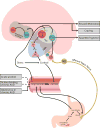Stress, Motivation, and the Gut-Brain Axis: A Focus on the Ghrelin System and Alcohol Use Disorder
- PMID: 29797564
- PMCID: PMC6252147
- DOI: 10.1111/acer.13781
Stress, Motivation, and the Gut-Brain Axis: A Focus on the Ghrelin System and Alcohol Use Disorder
Abstract
Since its discovery, the gut hormone, ghrelin, has been implicated in diverse functional roles in the central nervous system. Central and peripheral interactions between ghrelin and other hormones, including the stress-response hormone cortisol, govern complex behavioral responses to external cues and internal states. By acting at ventral tegmental area dopaminergic projections and other areas involved in reward processing, ghrelin can induce both general and directed motivation for rewards, including craving for alcohol and other alcohol-seeking behaviors. Stress-induced increases in cortisol seem to increase ghrelin in the periphery, suggesting a pathway by which ghrelin influences how stressful life events trigger motivation for rewards. However, in some states, ghrelin may be protective against the anxiogenic effects of stressors. This critical review brings together a dynamic and growing literature, that is, at times inconsistent, on the relationships between ghrelin, central reward-motivation pathways, and central and peripheral stress responses, with a special focus on its emerging role in the context of alcohol use disorder.
Keywords: Alcohol Craving; Ghrelin; Motivation; Reward Processing; Stress.
Copyright © 2018 Research Society on Alcoholism. This article has been contributed to by US Government employees and their work is in the public domain in the USA.
Conflict of interest statement
The authors report no biomedical financial interests or potential conflicts of interest. The content of this article is solely the responsibility of the authors and does not necessarily represent the official views of the National Institutes of Health.
Figures

Similar articles
-
Animal studies reveal that the ghrelin pathway regulates alcohol-mediated responses.Front Psychiatry. 2023 Mar 8;14:1050973. doi: 10.3389/fpsyt.2023.1050973. eCollection 2023. Front Psychiatry. 2023. PMID: 36970276 Free PMC article.
-
The role of the central ghrelin system in reward from food and chemical drugs.Mol Cell Endocrinol. 2011 Jun 20;340(1):80-7. doi: 10.1016/j.mce.2011.02.017. Epub 2011 Feb 24. Mol Cell Endocrinol. 2011. PMID: 21354264 Review.
-
Ghrelin: From a gut hormone to a potential therapeutic target for alcohol use disorder.Physiol Behav. 2019 May 15;204:49-57. doi: 10.1016/j.physbeh.2019.02.008. Epub 2019 Feb 7. Physiol Behav. 2019. PMID: 30738971 Review.
-
Role of ghrelin in drug abuse and reward-relevant behaviors: a burgeoning field and gaps in the literature.Curr Drug Abuse Rev. 2013 Sep;6(3):231-44. doi: 10.2174/1874473707666140205200532. Curr Drug Abuse Rev. 2013. PMID: 24502454 Review.
-
Intravenous administration of ghrelin increases serum cortisol and aldosterone concentrations in heavy-drinking alcohol-dependent individuals: Results from a double-blind, placebo-controlled human laboratory study.Neuropharmacology. 2019 Nov 1;158:107711. doi: 10.1016/j.neuropharm.2019.107711. Epub 2019 Jul 13. Neuropharmacology. 2019. PMID: 31310775 Free PMC article.
Cited by
-
Toward a consensus nomenclature for ghrelin, its non-acylated form, liver expressed antimicrobial peptide 2 and growth hormone secretagogue receptor.J Neuroendocrinol. 2023 Jan;35(1):e13224. doi: 10.1111/jne.13224. Epub 2022 Dec 29. J Neuroendocrinol. 2023. PMID: 36580314 Free PMC article. Review.
-
Psychological interventions for interoception in mental health disorders: A systematic review of randomized-controlled trials.Psychiatry Clin Neurosci. 2023 Oct;77(10):530-540. doi: 10.1111/pcn.13576. Epub 2023 Aug 9. Psychiatry Clin Neurosci. 2023. PMID: 37421414 Free PMC article.
-
Sugars and Sweet Taste: Addictive or Rewarding?Int J Environ Res Public Health. 2021 Sep 17;18(18):9791. doi: 10.3390/ijerph18189791. Int J Environ Res Public Health. 2021. PMID: 34574716 Free PMC article. Review.
-
The Emerging Science of Interoception: Sensing, Integrating, Interpreting, and Regulating Signals within the Self.Trends Neurosci. 2021 Jan;44(1):3-16. doi: 10.1016/j.tins.2020.10.007. Trends Neurosci. 2021. PMID: 33378655 Free PMC article. Review.
-
Novel paradigms for the gut-brain axis during alcohol withdrawal, withdrawal-associated depression, and craving in patients with alcohol use disorder.Front Psychiatry. 2023 Sep 29;14:1203362. doi: 10.3389/fpsyt.2023.1203362. eCollection 2023. Front Psychiatry. 2023. PMID: 37840804 Free PMC article.
References
-
- ADDOLORATO G, CAPRISTO E, LEGGIO L, FERRULLI A, ABENAVOLI L, MALANDRINO N, FARNETTI S, DOMENICALI M, D’ANGELO C, VONGHIA L, MIRIJELLO A, CARDONE S, GASBARRINI G. Relationship between ghrelin levels, alcohol craving, and nutritional status in current alcoholic patients. Alcohol Clin Exp Res. 2006;30:1933–7. - PubMed
-
- AKKISI KUMSAR N, DILBAZ N. Relationship between craving and ghrelin, adiponectin, and resistin levels in patients with alcoholism. Alcohol Clin Exp Res. 2015;39:702–9. - PubMed
-
- ANDERSON AK, PHELPS EA. Lesions of the human amygdala impair enhanced perception of emotionally salient events. Nature. 2001;411:305–309. - PubMed
-
- ASAKAWA A, INUI A, KAGA T, YUZURIHA H, NAGATA T, FUJIMIYA M, KATSUURA G, MAKINO S, FUJINO MA, KASUGA M. A role of ghrelin in neuroendocrine and behavioral responses to stress in mice. Neuroendocrinology. 2001a;74:143–7. - PubMed
Publication types
Grants and funding
LinkOut - more resources
Full Text Sources
Other Literature Sources

